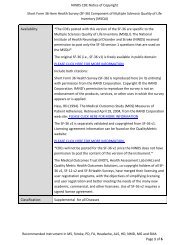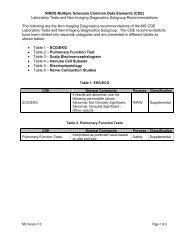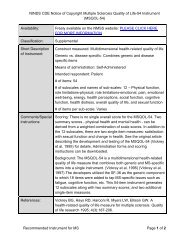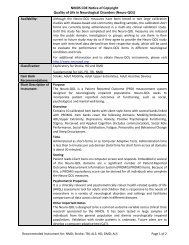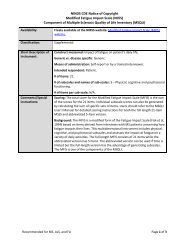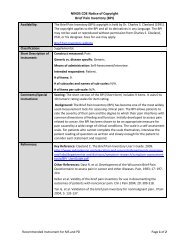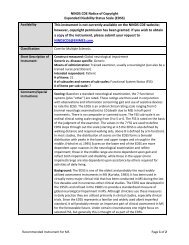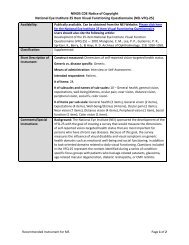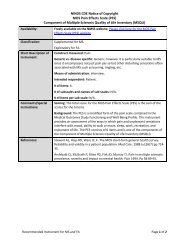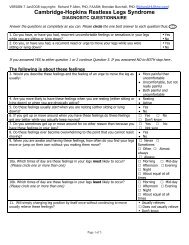NINDS CDE Huntington's Disease Behavioral Psychology Subgroup ...
NINDS CDE Huntington's Disease Behavioral Psychology Subgroup ...
NINDS CDE Huntington's Disease Behavioral Psychology Subgroup ...
You also want an ePaper? Increase the reach of your titles
YUMPU automatically turns print PDFs into web optimized ePapers that Google loves.
Description of Frontal Systems Behavior Scale forHD Common Data ElementsRationale/Justification (includeany information onlanguage andcountries/ cultures/ethnic groups wheretested)Validity:Construct validity: Reviewed in manual and acceptable.Convergent validity with other behavioral measures was high (NPI, r=.64).Discriminant validity also good (Grace).Feasibility: Informants completing the Family Rating Form should have at leastweekly contact with the patient to ensure accurate behavioral observation.Patients must have cognitive capacity to read and complete the form.Factor structure: An exploratory principal component factor analysis using thefamily version with 324 neurological outpatients (mainly HD, PD and Alzheimer’sdisease patients) confirmed a f actor structure consistent with the subscalesoriginally proposed on theoretical grounds (Stout).Sensitivity to Change/ Ability to Detect Change (over time or in response toan intervention): This measure was designed in part to assess change overtime.Known Relationships to Other Variables: There have been no p ublishedreports of patients with manifest HD using the FrSBe, other than the factoranalysis referred to above (Stout). In the PREDICT-HD study, 745 mutationpositivesubjects, 163 mutation-negative control subjects and their companionscompleted subject and family versions respectively of the FrSBE (Duff). Mutationpositivesubjects reported more frontal behaviours than mutation-negativecontrols, even though most subjects were more than 10 y ears from predictedmotor onset. However, discrepancies between self-report and companion scoressuggested impaired insight in those closest to predicted disease onset. In non-HD studies, Apathy and Executive Dysfunction subscale scores are correlatedwith IADL’s (Grace), and the Disinhibition scale score is strongly related tocaregiver burden (Grace).Diagnostic Sensitivity and Specificity, if applicable: N/AStrengths: Assesses multiple domains of frontal lobe functioning and allows forcomparison of premorbid behavior with current status. Also allows for comparisonbetween patient and caregiver reports.Weaknesses: Large number of items may be a problem for more cognitivelyimpaired subjects. Scoring requires normative database and understanding of Tscores.Availability (copyright): Through Psychological Assessment Resources, Inc. Thismeasure is copyrighted and cannot be reproduced without permission.http://www4.parinc.com/Products/Product.aspx?ProductID=FRSBESpecial Requirements for administration: NoneAdministration Time: The scale takes 10 minutes to administer and 10-15minutes to score.HD Version 1.0 Page 2 of 3



